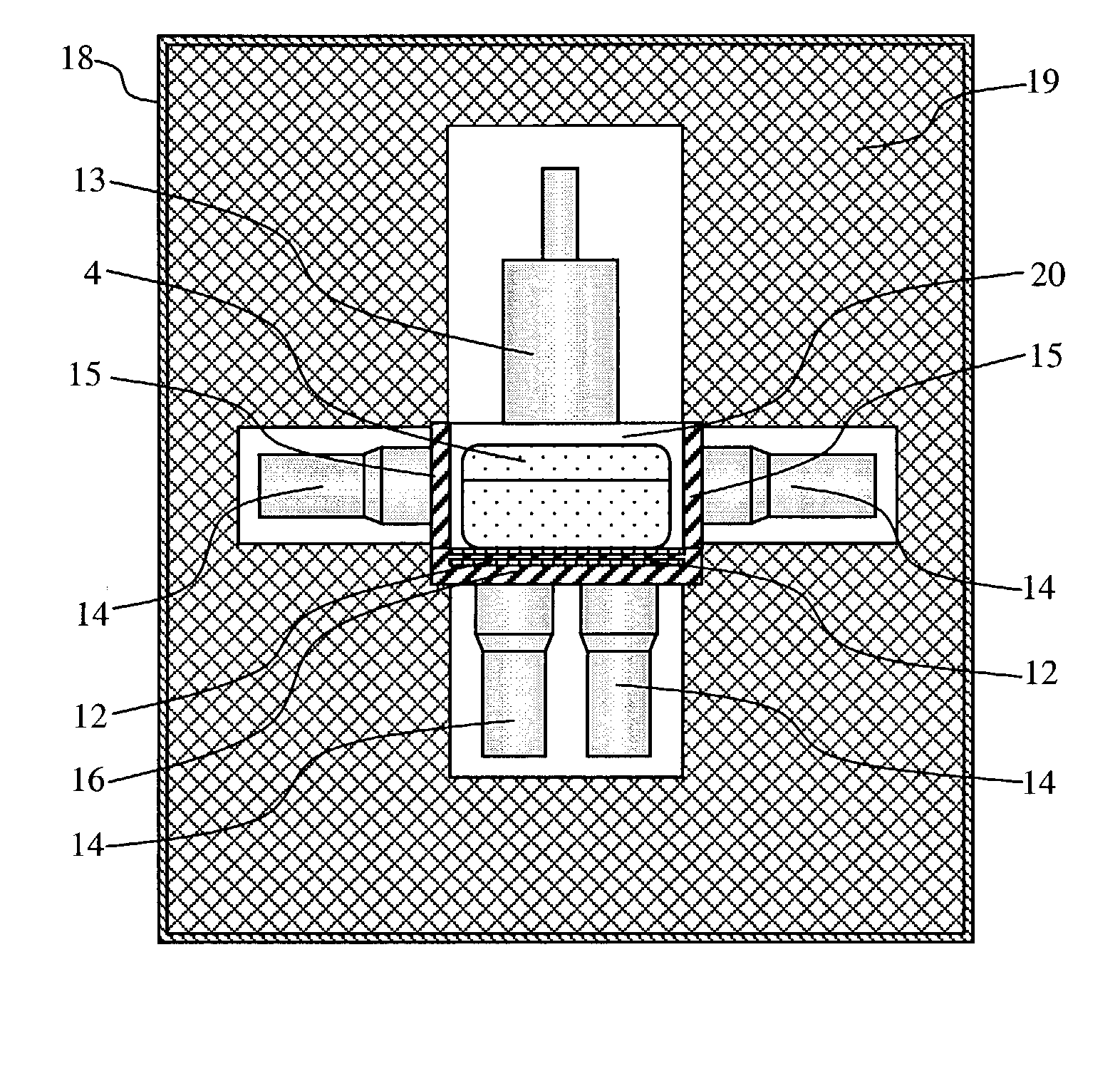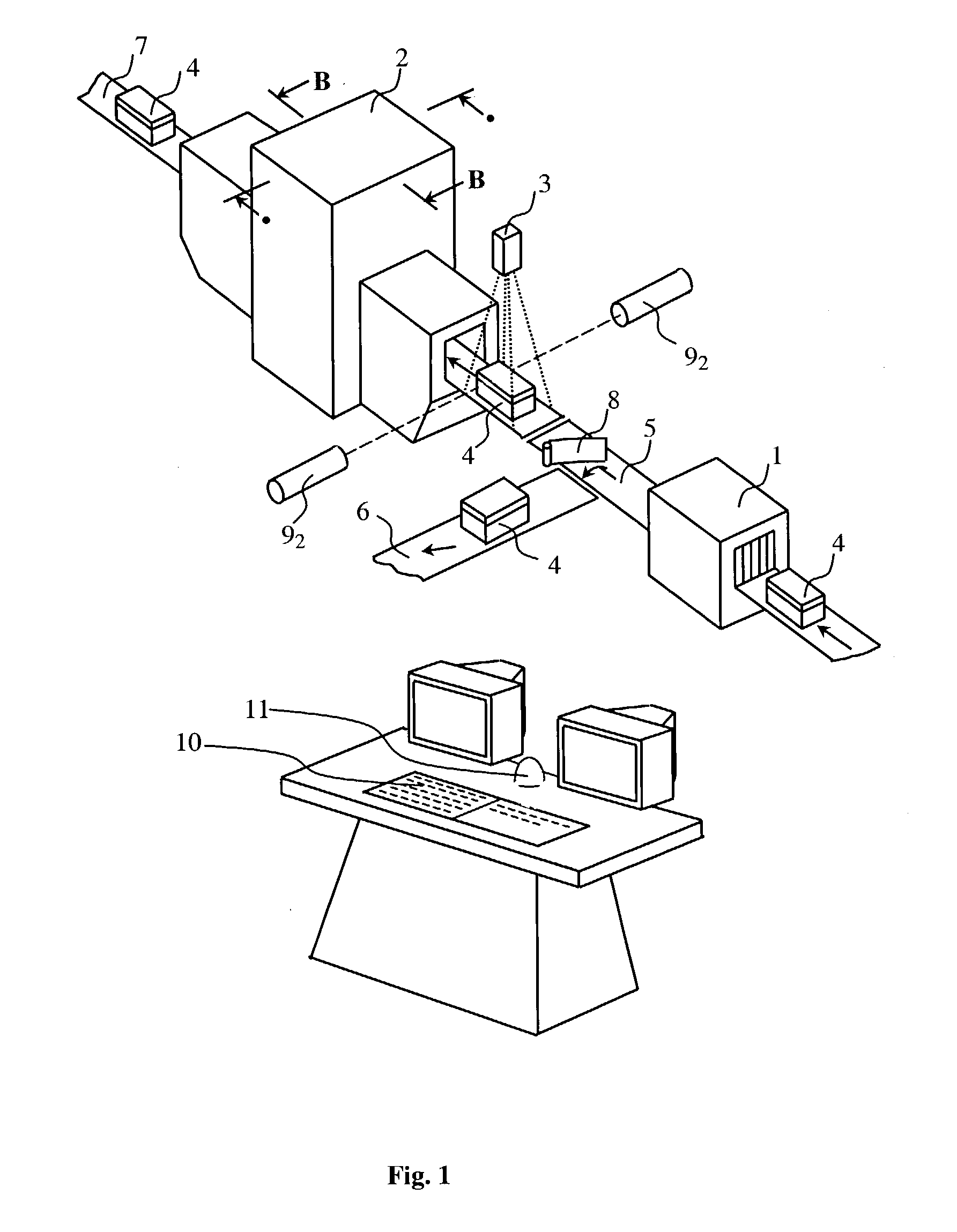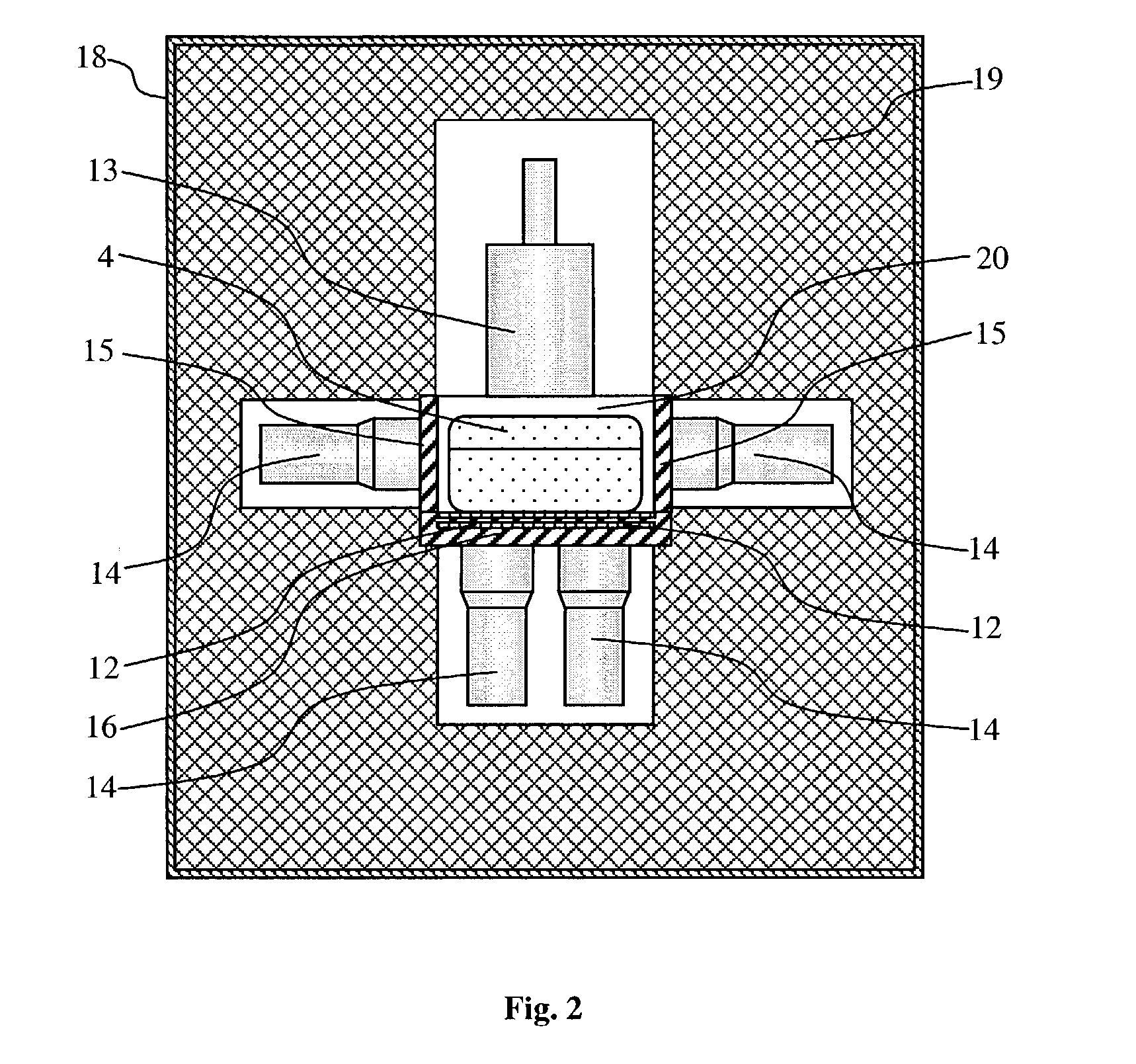This makes it difficult to effectively detect explosives made in unconventional configurations or masked by way of placing them, for instance, into bars of
soap or electronic devices.
Technical means implementing the aforementioned methods have a high sensitivity, but are incapable of detecting most powerful plastic explosives due to their very low
vapor pressure.
Moreover, these methods do not guarantee detecting all types of explosives if the latter are placed in a fluid-tight packing or specially treated packing.
First, this hampers locating the explosive in the object under investigation and, second, it increases the probability of false alarms.
Moreover, thresholds levels in detection of explosives by said prior art methods appears to be inadmissibly high since, on the average, only about 14% of nuclei of
nitrogen atoms contained in the explosive emit the above described gamma
radiation.
Practically all known materials that are not explosive, but cause false alarms due to the
high nitrogen density, e.g. nylon, silk,
wool, leather,
melamine, etc., have a
low oxygen density.
However, recording gamma rays of said
quantum energy without
cutting off the pulsed source of fast neutrons is complicated due to the presence of gamma
radiation having
quantum energies within the range of 5 to 7 MeV emitted during nuclear interactions of thermal and fast neutrons with nuclei of atoms of a number of other chemical elements, such as
chlorine,
manganese,
sodium or iron, since this makes it necessary to use detectors of a
very high resolution.
Such measures however lead to a longer overall screening time and require a greater sophistication in the design of units realizing prior art methods of the discussed type.
Furthermore, exposing the object under investigation to fast neutrons requires additional
radiation protection for the chamber in order to comply with the current national requirements for protection of the personnel and
population against the effect of
ionizing radiation, which leads to an increase in the
mass and dimensions of a unit implementing the prior art method.
Also, an increase of the
radiation dose absorbed by the object under investigation takes place, which can cause a deterioration of
consumer properties of industrial articles contained therein, e.g.
electronic equipment and photographic materials.
This leads to an increase in the mass and dimensions of the unit implementing the method, due to the necessity of additional
radiation protection measures, and increases the cost of the unit.
Second, this makes it necessary to
expose to neutrons the areas of the object under investigation that do not contain an explosive, but may contain non-explosive nitrogen- and
oxygen-containing materials, which materials, after the
exposure to thermal and fast neutrons, will emit gamma rays.
As a result, the probability of false alarms will increase.
Third, the unnecessary
neutron irradiation of areas of the object under investigation that do not contain an explosive increases the
radiation dose absorbed by articles within the object under investigation, e.g.
electronic equipment and photographic materials, which can cause an impairment of their
consumer qualities.
This circumstance leads, on the one hand, to an increase in the
explosive detection threshold when using this or other prior art methods.
Therefore, the described method, like all other prior art methods using X-ray
radiography and the
neutron radiation analysis in which the areas of an object under investigation with a density of organic materials higher than the established threshold value are exposed to thermal neutrons, does not allow ensuring the required low probability of a
false alarm, since the presence of an explosive is only judged by the value of intensity of 10.8 MeV gamma rays during radiation capture of thermal neutrons by nuclei of nitrogen-14 atoms.
In this case, the presence in the object under investigation of materials that are not explosive, but contain nitrogen in quantities similar to its content in explosives may lead to wrong decisions.
Ignoring their relative position in the prior art methods leads to a
distortion of results of gamma radiation recording, which may cause omission of the explosive, thus reducing the probability of correct detection.
Using such a low threshold value corresponding to the minimal mass of an explosive will considerably increase probability of false alarms caused by gamma rays emitted by non-explosive nitrogen-containing materials and by nitrogen of air.
Moreover, in practicing any of all existing methods based on the neutron radiation analysis the use of a thermal neutron radiator that has an invariable directional pattern, with its emitting surface forming a rather wide divergent beam of thermal neutrons, does not make it possible to
expose to thermal neutrons a small-size area having a density of organic materials greater than the established threshold value.
This leads to the inevitable
neutron irradiation of adjacent areas of the object under investigation that may contain non-explosive nitrogen-containing materials as well as air.
As a result, gamma rays are emitted by the non-explosive nitrogen-containing materials and the nitrogen of air contained in areas of the object under investigation adjacent to the area being exposed, which also increases the probability of a
false alarm.
Irradiating many areas of an object under investigation with a density of organic materials higher that the established threshold value also leads to an unjustified increase of the
radiation dose absorbed by articles contained in objects under investigation, which may result in an impairment thereof.
Consequently, the cavity can contain a considerable amount of air not replaced by the object under investigation.
When exposed to thermal neutrons, air will also emit gamma rays which, given the appreciable volume of remaining air, either will preclude a small mass of explosive from being detected or may cause a
false alarm due to the high background component of gamma rays from nitrogen of air present in the radiation-protected chamber.
In addition, virtually all known state-of-the-art methods do not include a step of the identification, by its X-ray image, of an article contained in the area of the object under investigation and having a density of organic materials higher than the established threshold value.
The absence of such information about the presence of such compact article in the area of the object under investigation being exposed to thermal neutrons decreases a probability of correct
explosive detection and does not make it possible to reduce the probability of a false alarm.
As shown by the above-presented analysis of the existing explosive detection methods, still unresolved to date remain major problems
stemming from an insufficiently
high probability of correct detection, a
high probability of false alarms, an increased
detection threshold of an explosive being detected, a prolonged time of explosive detection, an insufficient level of radiation safety, and a
high probability of deterioration of
consumer properties of certain industrial goods contained in an object under investigation as a result of checking.
However, in difference to 10.8 MeV gamma-rays, a direct recording 5.534 MeV and 5.266 MeV
cascade gamma-ray quanta is practically unfeasible owing to the presence of gamma rays with
quantum energies within a range of 5-6 MeV emitted during the interaction of thermal neutrons with nuclei of atoms of a number of other chemical elements, e.g.,
sulfur,
chlorine and
sodium.
Hence, in case of direct recording, presence of additional cascade gamma-ray quanta from said elements can lead to false alarms.
Using such a low threshold value corresponding to the minimal mass of explosive will lead to false alarms caused by gamma rays emitted by non-explosive nitrogen-containing materials and nitrogen of air.
First, this increases the level of radiation safety; second, decreases the probability of impairing consumer properties of such goods as photographic materials and
electronic equipment due to
exposure to neutrons; third, prevents non-explosive nitrogen-containing materials from thermal neutron
exposure, which areas will not in this case emit secondary gamma rays that may lead to a false alarm.
When small objects are placed for thermal neutron exposure in the radiation-protected chamber having dimensions designed for checking considerably larger objects, its cavity will inevitably contain a substantial volume of air not replaced by the object under investigation.
The volume of said air being great enough, this can cause a false alarm or prevent a small explosive mass from being detected owing to the significant background component of gamma rays of nitrogen in the air.
 Login to View More
Login to View More  Login to View More
Login to View More 


